#Religious Tract Society
Text

The History of insects, Imprint: London, Religious Tract Society, 1839.
1K notes
·
View notes
Photo

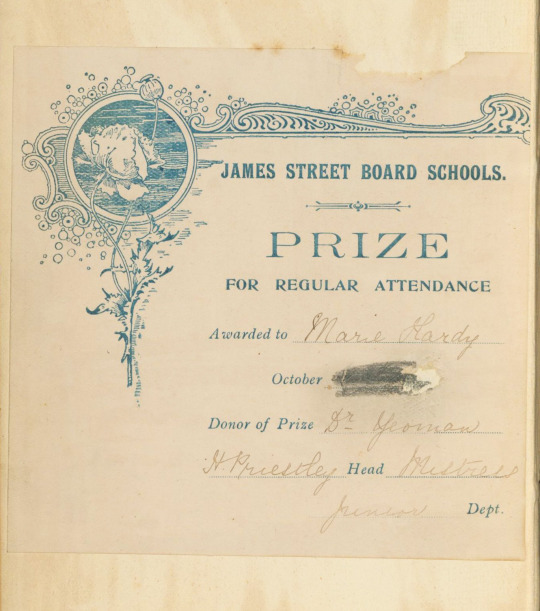

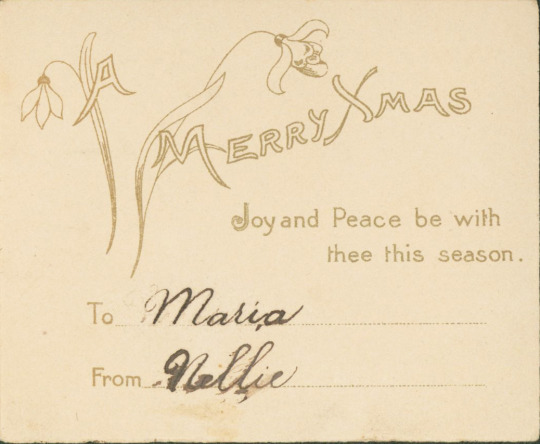

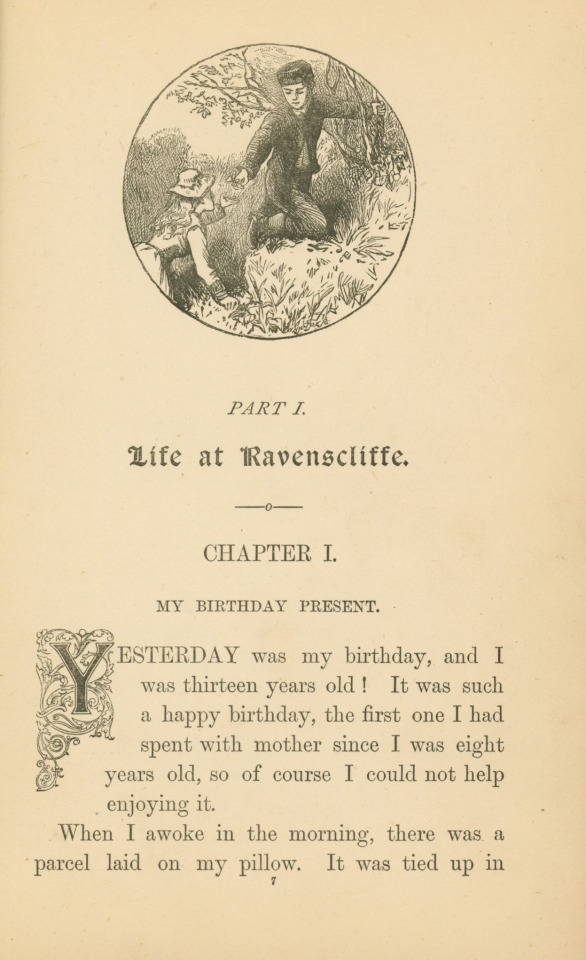

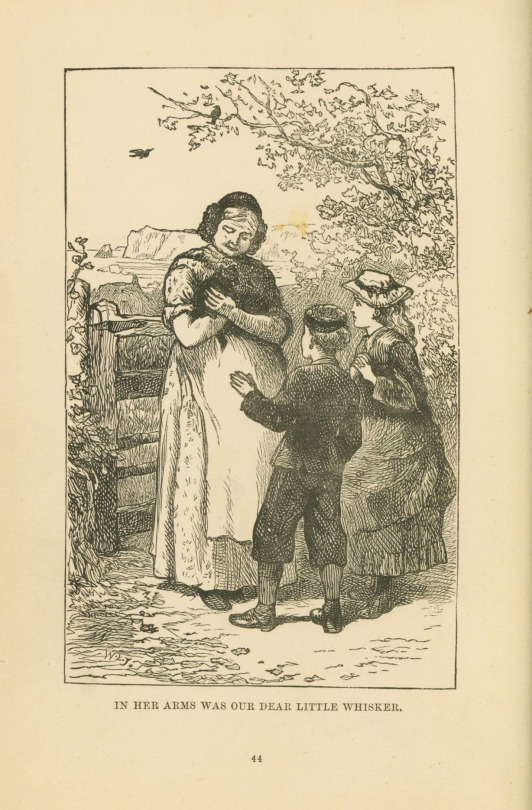

Publishers’ Binding Thursday
This week’s Publishers’ Binding Thursday is a lovely floral binding in raspberry, green, blue, and gold. The book is Olive’s Story by Mrs. O.F. Walton, published in London by the Religious Tract Society in 1882. Mrs. O.F. Walton is Amy Catherine Walton, who published under her husband Octavius Frank Walton’s name and became well known for her religious stories. The Religious Tract Society was an organization founded by British evangelical Christians in 1799 that published periodicals and books most often with religious themes. This book is part of our Historical Curriculum Collection.
The binding is a bid faded, but lovely, featuring raspberries, flowers, and leaves stamped in a raspberry color in alternating blue and green rectangular blocks. The title and author’s name sit in a gold rectangle—the title stamped in raspberry and the author’s name in blue. The spine features a similar design, with the insignia of the Religious Tract Society at the bottom.
There's also a sweet Christmas card from one friend to another tucked in, and the evidence of the book owner's award for good attendance!
View more Publishers’ Binding Thursday posts.
View more posts related to the Historical Curriculum Collection.
-- Alice, Special Collections Department Manager
#Mrs. O.F. Walton#Olive's Story#Publishers' Binding Thursday#Publishers' Bindings#Religious Tract Society#Amy Catherine Walton#evangelical christians#religious books#bindings#Historical Curriculum Collection#Alice
66 notes
·
View notes
Text

Some Old Types of Ships. Illustration from Sea Pictures by James Macaulay (Religious Tract Society, c 1880)
#naval art#infographic#some old ships#13th-17th century#age of discovery#age of sail#medieval seafaring
192 notes
·
View notes
Text

An unprecedented female monarch in her dynasty, Rudrama Devi (r.1262-1289) presided over an age of prosperity. A successful warrior queen, she triumphed over both internal and external threats.
Her father’s heir
Rudrama Devi was the daughter of King Ganapati Deva (r.1199-1262) of the Kakatiya dynasty, who ruled over parts of present-day Telangana and Andhra Pradesh in Southern India. Their capital was located at Orugallu (Warangal).
Ganapati Deva was a successful monarch. His kingdom was famed for its’ diamonds and beautiful fabrics. He had no son to succeed him and his older daughter was already married. He thus decided to make his younger daughter Rudrama Devi his heir and gave her the requisite training.
A female monarch would nonetheless be a in vulnerable position and see her legitimacy questioned. To make female rule more acceptable, he arranged a Putrikayagna ceremony for his daughter. This religious rite allowed a sonless man to declare his daughter or his daughter’s son as his son. After that, Rudrama Devi was also known by the masculine name of Rudra Deva. She also attended all public meetings in masculine attire.
Her story is similar in that regard to that of her near-contemporary, Raziya Sultan of Delhi.
A warrior among warriors
In 1259, Rudrama Devi became her father’s co-ruler and assumed sole rule in 1262. She married the Chalukya prince Virabdhadra, who played no part in her administration, and with whom she had three daughters.
Rudrama Devi faced many threats at once. Her neighbors saw an opportunity to conquer her kingdom and her feudatory noblemen couldn’t stand being ruled by a woman.
She stood her ground and prevailed, proving her might as a warrior queen. Many of her nobles rebelled, but she successfully defeated them. The Seuna Yadava king, Mahadeva, invaded her territories and reached her capital. Rudrama Devi chased him after 15 days of fighting and forced them to pay a heavy tribute in money and horses.
To commemorate her victory, she styled herself “Rayagajakesari” or “the lion who rules over the elephant kings”. In the pavilion she built, she was depicted as a warrior mounted on a lion, holding a sword and a shield, with an elephant trunk holding up a lotus to her in sign of submission.
In 1262, another of her neighbors occupied the Vengi region. She was able to recover it after 12 years of fighting. She was nonetheless unsuccessful in fending off the attacks of her southern rival Ambadeva.
Meritocratic policies
Rudrama Devi completed the construction of the nearly impregnable Warangal Fort. She bought large tracts of land under cultivation, increasing her kingdom’s revenue. She also recruited non-aristocratic warriors from diverse castes. Only 17 percent of her subordinates were of noble background. Prominent commanders could receive lands and become feudatory nobles. She thus established a new warrior class. Since the nobility had rejected her rule, this meritocratic policy allowed her to surround herself with loyal retainers.
Marco Polo, who mistook her for a widow of the previous king, wrote about her very flattering terms, calling her a “lady of much discretion” and a “lover of justice, of equity and of peace”.
A warrior to the end
At the end of her reign, she chose her grandson, Prataparudra, as her heir.
Rudrama Devi likely died in 1289 (though some sources date her death from 1295) according to an inscription made by a member of her army commemorating her recent death and that of her army chief. The cause and location of her death are unknown. She likely died facing Ambadeva's armies, leading her troops as she had always done.
Further reading
Gupta Archana Garodia, The women who ruled India, leaders, warriors, icons
Janchariman M., Perspectives in Indian History From the Origins to AD 1857
Talbot Cynthia, "Rudrama‐devi, Queen of Kakatiya dynasty (r. 1262–1289)", In: The Oxford Encyclopedia of Women in World History.
Talbot Cynthia, Precolonial India in Practice: Society, Region, and Identity in Medieval Andhra
#rudrama devi#13th century#history#women in history#women's history#historyedit#women's history month#india#indian history#queens#powerful women#women warriors#warrior women#historical figures#herstory
73 notes
·
View notes
Note
granny hilary, tell us about gay porn in monasteries

Oh, I KNEW that someone was going to ask for this as soon as I reblogged that post with those tags (from you, even!). So yes, Kristen, the pervert tumblr hordes thank you for your service.
As was the case in most medieval single-sex environments, the precise balance of gender politics/constant suspicion of possible queerness was a major concern for monasteries. I've written about this before in the context of military chivalry/knighthood, and how medieval society both encouraged knights to love each other more than anything (battlefield brotherhood etc etc) and worried about whether they would love each other SO much that they would then have, y'know, actual sex. This was also a prominent worry in monasteries, which shut a bunch of often-young men up together and told them to be holy and focus on prayers and not the OTHER things that young men like to think about. My esteemed colleague @oldshrewsburyian has previously written about lesbian nuns, who often formed intense emotional/romantic bonds with other nuns. Hildegard of Bingen herself is a famous example of this, and she wrote many love letters to and about another nun, Richardis von Stade, who is often described as her "intimate friend." Regardless of whether this relationship was physical or not, Hildegard also wrote about "ecstasies" experienced in spiritual union with the Virgin Mary, and other medieval female mystics did the same.
In regard to gay monks, The Name of the Rose by famed medievalist Umberto Eco presents a fictionalized version of this, where one of the monks is something of a local monastery gay playboy and has several other monk lovers who are all presumed to be jealous of each other and possibly willing to commit murder on his behalf. This was also because a large number of monks, especially at wealthier abbeys, weren't there because they had a specific or personal religious calling. It was a common career path for younger sons, getting them out of the way of their elder brother's inheritance of their father's lands and titles, and plenty of career churchmen were relatively secular and interested in worldly pleasure, no matter how hard the Cluniacs and similar reform movements tried to outlaw clergy marriage, concubinage, and other sexual sins. Clergymen were, as is also the case today, often suspected of committing sodomy on the sly or otherwise hypocritically engaging in gay sex, and monastic authors such as Peter Damian, Odo of Cluny, and others wrote endless polemical tracts insisting that priests and monks refrain from having sex with each other, and otherwise bewailing the so-called dismal state of moral relations in the church. Of course, the bulk of concern was over male monks committing sexual sins with women, but the worry over clerical sodomy was never insignificant either. The 12th-century Cistercian monk Aelred of Rievaulx also produced various writings that have been read as homosocial, homoerotic, or otherwise exalting religious same-sex male love.
We also see this gender tension a lot in terms of the accounts of women dressing up as men to enter all-male monasteries and have a male-coded religious experience. Some of them get accused of impregnating local women, which is obviously biologically impossible but may hint at an intimate relationship with said woman, and other monks often note their "attractiveness" or other physical qualities which is then used as proof in discovering their "real gender." This likewise reflects the concern that monks were finding each other attractive even when they WEREN'T secretly women (and the scholarly literature also argues over whether we should consider these women as wearing "male disguise" or as proto-transgender individuals adopting clothing and life experiences that matched their identified gender rather than their gender assigned at birth). As noted above re: Hildegard, intensely "queer" mystical religious experiences involving physical and passionate adoration of the body of Jesus Christ were also common to both genders. Men were encouraged to visualize themselves as the "bride of Christ," transcending the ordinary limits of gender and joining in mystical (and possibly sexual) union with Jesus, and women did the same thing with both Jesus and the Virgin Mary. So yes, the medieval church was a LOT more queer than all the stereotypes would have it. In many ways.
The 14th-century Lollards in England also positioned themselves as reacting against clerical/monastic sodomy and sexual sins, and the Dissolution of the Monasteries by Henry VIII also used the argument that those degenerate monks were all just in there screwing each other at all times, which was obviously rhetorical, but reflected a deeper real-world anxiety that this was in fact actually the case. So in other words: gay monks, like gay knights, absolutely did exist and deeply shaped the social rules, cultural environments, canon law, and everyday experience of their surroundings, even despite the wild unsexiness that is the tonsure haircut. Diversity win.
817 notes
·
View notes
Text
Pack Structure and Society hc
Hello its me im back with another long post. It was originally jsut supposed to be about packs but it got kinda mixed up with some other general society stuff. This is made for my writing personally so it's not even close to a one size fits all but feel free to take concepts u like !
As always stick around after the cut

🏔️ In my society packs are very central. My au isn’t total traditional, but I do take a lot of the more traditional stances when it comes to packs.
🏔️ Packs are typically a mix of blood relatives. It’s much more rare than you’d think to find a found family kind of pack where no one is related
🏔️ Packs are lead by the pack head, traditionally an alpha. A pack will also have a second, traditionally an alpha or beta. Large packs have a few more designations as well. The heart is the packs top omega usually unrelated /unmated to the head. Some packs also have a matchmaker, usually an omega in charge of choosing mates and giving relationship counseling. Some packs have a finance head, exactly what it sounds like usually a beta in charge of money and land. All packs typically have at least one pack paw. A paw is the pack’s muscle, think palace guards in fantasy aus. Large and rich packs will have enough paws to elect a paw head to coordinate their protection. Paws are traditionally alphas. Packs that are very religious will often have a religious leader as well. Their title varies from religion to religion as do their dynamics. This is sometimes different than like a priest in a church in a neutral town (keep reading for those) and sometimes not.
🏔️ The power hierarchy in order is:
--Pack Head
--Second
--Paw Head (optional)
--Heart (optional)
--Finance Head (optional)
--Matchmaker (optional)
The religious head is not included as their place on the hierarchy can vary depending on religion and culture.
🏔️ In very traditional packs (most of them in my au) these positions are passed down by blood. As such each of these power positions is controlled by a different family, not mated pairs.
🏔️ Most packs tend to hold counsels with all these positions in attendance when big decisions are made, but at the end of the day what the pack head says goes.
🏔️ Packs can vary in size, but for my world building im going to focus on larger, rural area packs
🏔️ These large packs typically own quite a bit of land! Members are usually spread out over multiple buildings with the largest property functioning as the pack head’s home and a communal space. The pack head’s door is always unlocked.
🏔️ All buildings are usually within walking distance making my world a hell of a lot more rural than irl as you have these large tracts of pack-owned wilderness between villages
🏔️ A pack on the smaller end probably only has one village, or cluster of dwellings whatever you wanna call it ig, while larger packs can have three or four. In this case there’s usually some kind of town hall type meeting for all members to mingle a few times a month.
🏔️ These packs are self governing. Usually the heart and the head paw are in charge of discipline and justice, with the blessing of the pack head.
🏔️ Since packs are self governing, packs have the power to execute, tho it is rare. Usually an offending member is outsourced to a private or government run prison, but in extreme cases a pack can legally kill
🏔️ Traditional packs are extremely territorial, and trespassing is one of those cases punishable by death
🏔️ Packs have a… long…. Complicated… history of alliances and enemies it can be super confusing for someone new to the area
🏔️ Packs do take in packless people from time to time. It can happen more formally or more relaxed. Formally a pack will seek individuals at shelters for packless, rehabilitation centers, or finishing schools. More laid back packs will simply advertise.
🏔️ Packs also arrange marriages between their allied packs (which in the 21st century can span across the entire globe) and some are known to buy omegas in particular
🏔️ There are towns/cities on neutral grounds where pack borders meet. These towns are government owned and run and often have all the little shops and markets and religious centers and hospitals and pharmacies and movie theaters and libraries and what have you. Pack members can visit these neutral towns anytime they want! Tho very strict packs will not allow their omegas out on their own without a chaperone
🏔️ While each pack is different, it’s not uncommon for packs in my setting to adopt a representative animal to act as a logo/crest of sorts! Some packs can be very closed to outsiders and these are the ones that often have their members tattooed or branded with the animal for recognition and a rite of passage
🏔️ While packs in a country/area do have cultural things in common they can also differ widely. 3 packs might be neighbors in territory, but one is devout Catholic while another is made of Wiccans and moon worshippers while another still are totally agnostic and are just really passionate about a certain football team. Stepping into a different pack can feel like transporting yourself to a different world/time.
🏔️ There are two kinds of schools in this world: public government owned ones that are in the neutral towns that any area pack can attend, or private home schooling left up to the packs (but the government does check in on certain milestones for these ones) I'll make a different schooling hc later !
🏔️ Most of the packs in this world are pre established. New packs are often met with hostility.
🏔️ Packs almost always meet on neutral ground no matter if the function is positive (a mating dance perhaps or a holiday event) or negative (bickering over where the real border is)
🏔️ Some packs are self sufficient and farm and hunt on their own. These packs have lots of betas !
🏔️ Other packs rely on the neutral towns to provide for them, so their villages tend to be close to the border.
🏔️ Pack wars are mostly a thing of the past, they don’t really happen much tho certain packs are hostile towards other ones.
🏔️ All packs have a scent to them, you can tell when a person is of a certain pack or not and pack bonds are usually maintained by platonic scenting.
🏔️ Some packs desperately search for new members as they have issues with interbreeding
🏔️ Money is less of an issue in my world, a packs main source of income are usually a few working alphas and betas and if some betas and omegas decide to sell produce in the neutral towns. The central government will provide a ton of social services so these traditional packs (who are often considered like a cultural thing important to preserve) don’t struggle in modern times.
🏔️ A pack will typically have less omegas compared to another dynamic, they’re more rare! It’s why some packs take protecting their omegas so seriously. In ancient times rogue or enemy packs were even known to steal and forcibly bond omegas from other packs. The protective instincts have remained even tho this is heavily illegal now and would be grounds for one pack to kill members of the other.
🏔️ Nature and land is way more important than irl !! Most packs keep their lands pristine wilderness they use for hunting or recreation. There are a few packs who have donated certain lands to the government to be preserved as national parks all packs can enjoy. Overall tho destruction of wilderness is taken so so seriously.

#omegaverse#a/b/o#a/b/o verse#alpha beta omega#a/b/o dynamics#omega#alpha#beta#worldbuilding#alpha/beta/omega verse#packs
25 notes
·
View notes
Text

ADVENTURES IN BIRD LAND by Oliver G. Pike (London: Religious Tract Society, 1907) Illustrated with greyscale photos and line drawings.
#beautiful books#book blog#books books books#book cover#books#vintage books#illustrated book#edwardian books#birds#ornithology#birdlovers#wild birds
55 notes
·
View notes
Text
My soverain lord and fader, I recomande me to yowr good and gracieux lordship as humbly as I can, desiring to heere as good tydyngges of you and of your hye estat as ever did leige man of his soverain lord. And, sir, I trust to God that ye shal have now a companie comyng with my brother of Bedford that ye shal like wel in good feith as hit is do me wite, neverthelatter, my brother's mainy [retinue] have I seyn, which is right a tal meyny [retinue]. And so schal ye se of thaym that be of your other captaines leding, of which I sende you al the names in a rolle be the berer of this. Also so, sir, blessid be God, of the good and gracieux tydingges that ye have liked to send me word of be Herford your messager which were the gladdist that ever I mygt heve next your welfare, be my trouth, and, sir, with Godde's grace I shal sende all thise ladies as ye have commandid me, in al hast, beseching you of your lordship that I mygt wite how that ye wolde that my cosine of York [Joan Holland, dowager Duchess of York] shuld reule her, whether she shuld be barbid [dressed as a widow] or not as I have wreten to you, my soverain lord afore this time. And, sir, as touching Tiptot he shal be delivered in al hast, for ther lakkith no thing but shipping, which, with Goddes grace, shall be so ordeined for that he shal not tary. Also, sir, blessid be God, your gret ship the Grace Dieu is even as redy and is the fairest that ever man saugh, I trowe in good feith. And this same day therle of Devonshir my cosin maad his moustre [muster] in her and al other have her [there] moustre [mustered (?)] the same tyme that shall go to ye see [sea]. And, sir, I trowe ye have on [one] comyng toward you as glad as any man can be as fer as he shewith, that is the King of Scotts, for he thanketh God that he shal mow shewe be experience thentente of his good will be the suffrance of your good lordship. My soverain lord, more can I not write to your hynesse at this tyme, but yt ever I beseche you of your good and gracieux lordship as be my trouth my witting [knowingly] willingly I shal never deserve the contrary, that woot God, to whom I pray, to send yow al yt yowr hert desireth to his plaisance. Writen in your town of Hampton the xiiij day of May.
Your trewe and humble liege man and sone
H. G. [Henricus Gwalliae, or for Henry Prince de Galle.]
Letter written by Henry, Prince of Wales to his father, Henry IV, 14 May 1411(?) From: W. J. Hardy, The Handwriting of the Kings and Queens of England, The Religious Tract Society, 1893.
7 notes
·
View notes
Text
Brahmin supremacy
Social hierarchy: The Brahmins established a social hierarchy in which they occupied the topmost position, giving them immense power and control over other communities and perpetuating systems of oppression.
Caste system: Brahmins created and maintained the caste system, which divided society into rigid hierarchies based on birth. This system reinforced Brahmin dominance and enabled them to control the resources and opportunities available to different groups.
Caste-based violence: The Brahmins perpetuated violence against lower caste communities, particularly Dalits, through the caste system, which allowed for institutionalized discrimination and violence.
Marriage practices: The Brahmins established strict rules around marriage and family structures, which helped to perpetuate their social and economic power.
Religious monopoly: Brahmins claimed a monopoly over religious knowledge and practice, which allowed them to control and manipulate the spiritual lives of others. This further reinforced their social and political power.
Religious hegemony: The Brahmins established themselves as the custodians of religious knowledge and texts, giving them significant influence over religious practices and beliefs across South Asia.
Cultural appropriation: The Brahmins appropriated and assimilated elements of indigenous cultures and traditions, erasing the contributions of other communities and further consolidating their power.
Intellectual property: The Brahmins often appropriated the knowledge and intellectual property of other communities, erasing their contributions and further consolidating their own power and influence.
Education: The Brahmins monopolized education, particularly in the pre-colonial period, creating a system that privileged their knowledge and excluded other communities from accessing educational opportunities.
Education: Brahmins controlled access to education and knowledge, which further reinforced their social and economic dominance. They monopolized education and ensured that only members of their own caste could become scholars, priests, and teachers.
Land ownership: Brahmins acquired vast amounts of land through various means, such as gifts from kings or temples, and used their wealth and power to further consolidate their control over society.
Land ownership: The Brahmins, particularly in colonial times, acquired large tracts of land, often through exploitative means, consolidating their economic and political power.
Language and literature: The Brahmins established Sanskrit as the language of knowledge and literature, excluding other languages and literary traditions from the mainstream.
Language dominance: Brahmins promoted the use of Sanskrit, which was the language of the elite and the language of many Hindu religious texts. This gave them further linguistic dominance and helped to consolidate their cultural and political power.
Political influence: The Brahmins have played a significant role in shaping political structures and institutions across South Asia, often to their own advantage.
Systematic exclusion of lower castes from religious and social institutions
Appropriation of land and resources from indigenous communities
Imposition of Sanskrit as the language of power and knowledge, leading to the neglect and suppression of other regional languages and cultures
Establishment of a rigid caste system, with Brahmins at the top and other castes relegated to lower social status and economic opportunities
Monopolization of education and intellectual discourse, leading to the suppression of dissenting voices and alternative knowledge systems
Co-optation of indigenous spiritual practices and beliefs, leading to the marginalization and erasure of non-Brahmin religious traditions
Control over political power and governance through the Brahminization of the state
Promulgation of patriarchal norms and practices, leading to the subjugation and exploitation of women and other gender minorities
Promotion of vegetarianism as a moral and ethical ideal, leading to the marginalization and stigmatization of non-vegetarian communities
Use of violence and coercion to maintain Brahmin hegemony and suppress dissenting voices and movements
Creation of a cultural hegemony that has influenced and shaped the social, political, and economic structures of South Asia for centuries
Control over the production and dissemination of knowledge, leading to the suppression of alternative epistemologies and worldviews
Consolidation of economic power through the control of trade networks and commercial enterprises
Implementation of discriminatory and oppressive laws and practices against lower castes and non-Brahmin communities
Maintenance of a system of inherited privilege and power that has perpetuated Brahmin domination across generations
Control over religious and cultural practices, leading to the erasure and marginalization of non-Brahmin traditions and beliefs
Construction of a narrative of Brahmin superiority and moral authority, leading to the internalization of caste-based discrimination and oppression by non-Brahmin communities
Establishment of a culture of fear and intimidation, leading to the suppression of dissenting voices and the perpetuation of Brahmin hegemony
Appropriation and commercialization of cultural artifacts and practices, leading to the exploitation and erasure of indigenous communities and traditions
Creation of a caste-based system of labor and economic exploitation, leading to the marginalization and impoverishment of lower castes and non-Brahmin communities.
#brahmin#hindu#hinduism#hindutva#india#jai hind#south asia#religion#brahmin supremacy#brahminization#meluhha#indus valley#dalit#bahujan#tamil#dravidian
24 notes
·
View notes
Text
In important ways, a woman's behavior is less regulated now than it was in the past. She has more mobility and is less confined to domestic space. She enjoys what to previous generations would have been an unimaginable sexual liberty. Divorce, access to paid work outside the home, and the increasing secularization of modern life have loosened the hold over her of the traditional family and, in spite of the current fundamentalist revival, of the church. Power in these institutions was wielded by individuals known to her. Husbands and fathers enforced patriarchal authority in the family. As in the ancien régime, a woman's body was subject to sanctions if she disobeyed. Not Foucault's royal individual but the Divine Individual decreed that her desire be always "unto her husband," while the person of the priest made known to her God's more specific intentions concerning her place and duties. In the days when civil and ecclesiastical authority were still conjoined, individuals formally invested with power were charged with the correction of recalcitrant women whom the family had somehow failed to constrain.
By contrast, the disciplinary power that is increasingly charged with the production of a properly embodied femininity is dispersed and anonymous, there are no individuals formally empowered to wield it; it is, as we have seen, invested in everyone and in no one in particular. This disciplinary power is peculiarly modern: It does not rely upon violent or public sanctions, nor does it seek to restrain the freedom of the female body to move from place to place. For all that, the invasion of the body is well-nigh total: The female body enters “a machinery of power that explores it, breaks it down and rearranges it.” The disciplinary requirements through which the "docile bodies" of women are constructed aim at a regulation which is perpetual and exhaustive—a regulation of the body's size and contours, its appetite, posture, gestures, and general comportment in space and the appearance of each of its visible parts.
As modern industrial societies change and as women themselves offer resistance to patriarchy, older forms of domination are eroded. But new forms arise, spread, and become consolidated. Women are no longer required to be chaste or modest, to restrict their sphere of activity to the home, or even to realize their properly feminine destiny in maternity: Normative femininity is coming more and more to be centered on woman's body—not its duties and obligations or even its capacity to bear children, but its sexuality, more precisely, is presumed heterosexuality and its appearance. There is, of course, nothing new in women's preoccupation with youth and beauty. What is new is the growing power of the image in a society increasingly oriented toward the visual media. Images of normative femininity, it might be ventured, have replaced the religiously oriented tracts of the past. New too is the spread of this discipline to all classes of women and its deployment throughout the life-cycle. What was formerly the speciality of the aristocrat or courtesan is now the routine obligation of every woman, be she a grandmother or a barely pubescent girl.
-Sandra Lee Bartky, Femininity and Domination: Studies in the Phenomenology of Oppression
12 notes
·
View notes
Text

Artist
William Williams, Sr., 1727 - 27 Apr 1791
Sitter
Benjamin Lay, c. 1681 - 3 Feb 1759
Colchester, England
Although small in stature, Quaker reformer Benjamin Lay loomed large in the emerging eighteenth century antislavery movement. Having witnessed the horrors of slavery as a merchant in Barbados, Lay dedicated himself to abolitionism. In 1731, he set out for Pennsylvania, where he resumed his campaign against slavery, writing pamphlets and speaking out at Quaker meetings. At the time, members of the Religious Society of Friends, as Quakers are formally known, enslaved people and participated in the slave trade.
Benjamin Franklin’s wife, Deborah, owned this portrait of Lay. Although Franklin was an enslaver, his printing shop had published Lay’s abolitionist tract “All Slave-keepers that Keep the Innocent in Bondage, Apostates,” in 1738. Here, Lay stands before his cave-like home, holding a treatise “on happiness” by the English Quaker philosopher Thomas Tryon. Shortly before Lay’s death, the Philadelphia Society of Friends passed a resolution expelling members who traded enslaved people.
Smithsonian
17 notes
·
View notes
Text
Hey, uh, TESBLR.
Why did I just find a ESO character who is a White Woman Redguard who writes lore books that sound like this:
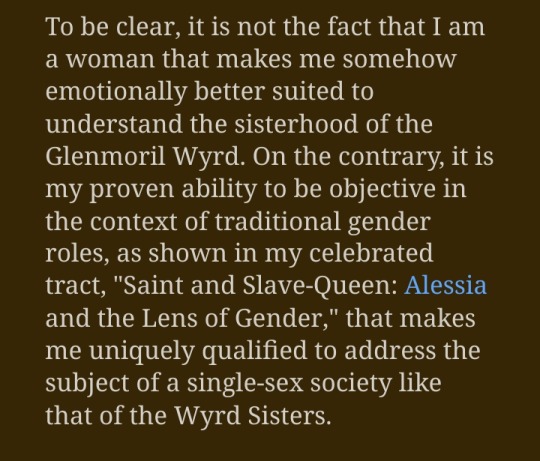
(TRANSCRIPT: To be clear, it is not the fact that I am a woman that makes me somehow emotionally better suited to understand the sisterhood of the Glenmoril Wyrd. On the contrary, it is my proven ability to be objective in the context of traditional gender roles, as shown in my celebrated tract, "Saint and Slave-Queen: Alessia and the Lens of Gender," that makes me uniquely qualified to address the subject of a single-sex society like that of the Wyrd Sisters)
Like... Checked some of her other work, one of her book is about the fucking Jungles of Cyrodiil, another is about how Aedra Good Daedra Bad is based on the fact that Cyrodiil cultural and religious hegemony, did ESO fucking make a strawman scholar using typical fandom talking points about the lore so that they could have her calm and collected male colleague dunk on her with "facts and logic" or some shit?
Especially given his use of gendered insults to describe her, or the fact he apparently propositioned sex to her on several occasions.
No the Saint Alessia book based on gender is not an actual lore book btw, sorry.
5 notes
·
View notes
Text
I finally have digital copies of every book made specifically to educate formerly enslaved Black Americans! This has been such a delightful adventure.
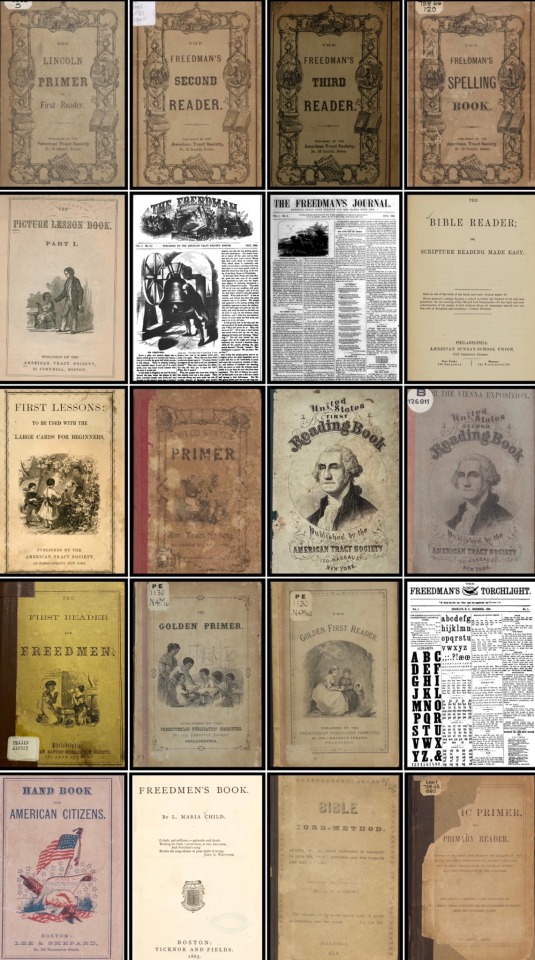
Most books made specifically for freed people were created by experienced religious publishers. That’s how they were able to make specialized books so quickly. The first book created specifically to educate former slaves was The Picture Lesson Book by the American Tract Society in Boston. It was published less than a year after the beginning of the Civil War, around March 1862. It was quickly followed by The Bible Reader by the American Sunday School Union. A few months later, the American Tract Society in New York published First Lessons. The American Baptist Publication Society and the Presbyterian Publication Committee also published a few books in later years.
In addition to all these, there were a handful of books published by smaller organizations or dedicated individuals.
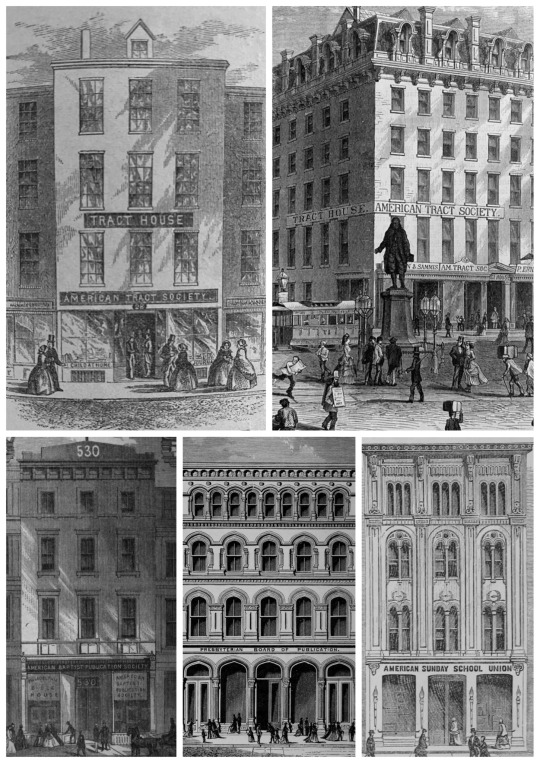
9 notes
·
View notes
Text
Today in Christian History

Today is Thursday, August 4th, the 216th day of 2022. There are 149 days left in the year.
Today’s Highlight in History:
1538: At the order of King Henry VIII of England, the rich priory at Walsingham is surrendered to the royal commissioner William Petre to be dissolved. Dedicated to the Virgin, the place had been a favorite destination of pilgrims, including Erasmus (who later lampooned such pilgrimages). King Henry VIII himself had once made a pilgrimage there, supposedly walking barefoot from Bareham, with his first wife, Catherine.
1642: Dutch minister Johannes Megapolensis arrives with wife and family to pastor in America.
1708: Death in Accomack, Virginia, of Francis Makemie, an Irish missionary who established the first Presbyterian church in America. His acquital in New York for preaching without a license, obtained with the help of leading New England Congregationalists, is viewed as a landmark in freedom of religion in America.
1713: Death in Windsor, Berkshire, England, of William Cave, an eminent scholar and churchman, who wrote Apostolici: or, The History of the Lives, Acts, Death, and Martyrdoms of Those Who Were Contemporary with or Immediately Succeeded the Apostles. As Also the Most Eminent of the Primitive Fathers for the First Three Hundred Years. To Which Is Added, a Chronology of the First Three Ages of the Church.
1789: In an attempt to appease the anger of French revolutionary masses, the clergy of France renounce their titles and many customary fees. Despite these concessions, France will soon begin to pass laws stripping religious institutions of privileges and property.
1821: Reverend William C. Blair, the first Sunday school missionary of the United States, begins his work. In his first year, he will travel twenty-five hundred miles, mostly on horseback, visiting six states, founding sixty-one Sunday schools, inspecting thirty-five others, establishing four adult schools and six tract societies. When later giving his report, he will apologize that illness hindered him from doing more. The Sunday and Adult School Union will be so impressed, however, that they will hire additional missionaries.
1888: In a blinding rain, Mary Slessor boards the canoe of a friendly chief who is to take her up river to a new work among Nigeria’s people.
1892: Dr. Wilfred T. Grenfell arrives in Labrador to work with colonists who have little medical attention, live in poverty, and are deeply in debt to company stores. The twenty-six-year-old English medical missionary will ply the Labrador shores in his mission boat or ski to where he is needed. Not only does he open hospitals and orphanages but he builds churches and teaches the people practical methods of management. He will work among them for forty-two years, raising funds and recruiting many other doctors, nurses, and clergymen to join him.
1930: Nicholas Frolovich Blazhnov, a reader in the Russian Orthodox Church, is arrested by Communist authorities. Five months later, he will be sentenced to death and executed within a few weeks.
#Today in Christian History#August 4#2022#death of William Cave#Reverend William C. Blair begins his work#death of Francis Makemie#Dr. Wilfred T. Grenfell arrives in Labrador#the clergy of France renounce their titles and many customary fees
2 notes
·
View notes
Text
Exploring the Nutritional Wonders of Cow Ghee
In the realm of culinary delights, few ingredients can rival the time-honored allure of cow ghee. Revered for its rich flavor, velvety texture, and remarkable health benefits, cow ghee has been a staple in kitchens around the world for centuries. Derived from the clarified butter of cow's milk, this golden elixir transcends its humble origins to become a symbol of culinary excellence and nutritional prowess.
Cow ghee is not just any cooking fat; it is a nutritional powerhouse packed with essential nutrients that promote overall well-being. Rich in vitamins A, D, E, and K, as well as conjugated linoleic acid (CLA) and medium-chain triglycerides (MCTs), cow ghee offers a host of health benefits that extend far beyond its delectable taste.
One of the most notable qualities of cow ghee is its high smoke point, which makes it an ideal choice for high-temperature cooking methods such as frying and sautéing. Unlike many vegetable oils that can become unstable and release harmful compounds when heated, cow ghee remains stable, ensuring that your dishes are not only delicious but also free from oxidative damage.
Furthermore, cow ghee is celebrated for its ability to support digestive health. According to Ayurveda, the ancient Indian system of medicine, cow ghee possesses a unique combination of fatty acids that promote the secretion of gastric juices, aiding in digestion and alleviating symptoms of indigestion and bloating. Its lubricating properties also help soothe the digestive tract, making it particularly beneficial for individuals with sensitive stomachs or digestive disorders.
But perhaps the most remarkable aspect of cow ghee is its role in promoting cardiovascular health. Contrary to popular belief, research suggests that moderate consumption of saturated fats, such as those found in cow ghee, may actually improve cholesterol levels and reduce the risk of heart disease. Additionally, the presence of CLA in cow ghee has been linked to lower inflammation and improved insulin sensitivity, further supporting cardiovascular health.
In addition to its nutritional benefits, cow ghee also holds cultural significance in many societies around the world. In Indian culture, cow ghee is revered as a symbol of purity and prosperity, often used in religious ceremonies and festive celebrations. Similarly, in Middle Eastern and Mediterranean cuisines, clarified butter plays a central role in traditional dishes, adding richness and depth of flavor to everything from savory stews to decadent desserts.
In conclusion, cow ghee is more than just a cooking fat; it is a culinary treasure with a rich history and an array of health benefits. From its ability to enhance the flavor of dishes to its potential to support digestive and cardiovascular health, cow ghee truly deserves its place in every kitchen. So, the next time you reach for a cooking fat, consider adding a dollop of cow ghee to your culinary repertoire—you won't be disappointed.
0 notes
Text
Colonialism is a historical phenomenon that occurred when the European powers invaded and colonized various parts of the world. It is an era marked by exploitation, oppression, and theft from indigenous people. One such example can be seen in South Africa with the Ndebele tribe. The period of colonization in this region left lasting scars on the indigenous population, especially the Ndebele tribe, which was robbed not only of their land but also their cultural identity, social structures, and economic stability.
The Ndebele people are one of the ethnic groups in South Africa who suffered immensely at the hands of colonialists. They were dispossessed of their lands by settlers who sought to exploit its rich resources for their gain. This act resulted in severe socio-economic implications for these people as they lost access to fertile farming lands which had been their primary source of livelihood for centuries. Additionally, it led to displacement and forced labor under harsh conditions on farms owned by white colonizers. Both these factors significantly disrupted their traditional ways of living and pushed them into poverty.
Apart from physical dispossession, another significant loss inflicted upon the Ndebele tribe was that of cultural identity. Colonialists imposed their culture and language onto the indigenous people, undermining native traditions and customs. The erosion started with Christian missionaries converting many natives to Christianity thereby diluting traditional religious beliefs. Simultaneously languages like Dutch and English were enforced as mediums of instruction in schools replacing local languages like isiNdebele. These attempts were driven by a misguided belief in the superiority of Western culture leading to a gradual fading away of Ndebele's unique cultural heritage.
Moreover, colonization severely damaged social structures among native tribes including Ndebeles’. Before colonization, African societies functioned based on communal ownership where resources were shared equally among community members. However, with colonial intrusion came individualistic ideals that contradicted these age-old practices resulting in deep-rooted societal divisions among tribal communities that persist even today.
These detrimental effects did not end with the cessation of colonial rule; they have seeped into contemporary South African society presenting grave challenges for present-day Ndebeles’. Post-colonial governments have tried albeit unsuccessfully to fully restore stolen lands back to natives due to bureaucratic red tape and political resistance from those still holding onto large tracts obtained during colonial times.
Furthermore, despite efforts towards decolonization through education policy reforms aimed at promoting mother tongue instruction over foreign languages in schools there still exists a strong bias towards English reflecting residual impacts from past domination.
Inequality remains rife within South African society as evident by persistent socioeconomic disparities between black Africans including Ndebelas’ and whites inherited from colonial times. Many black South Africans continue to live marginalized lives trapped in poverty while whites enjoy relatively higher standards of living - an unjust reality rooted firmly in history.
Lastly, although contemporary South Africa celebrates its multicultural diversity proudly showcasing each group’s unique heritage including that of Ndebelles’, true recognition remains elusive due largely to lingering stereotypes propagated during colonial times portraying Africans as 'primitive' or 'backward'.
Overall, it is undeniable that colonialism stole much more than tangible assets from indigenous tribes like the Ndebele; it snatched away their dignity leaving long-lasting scars etched deeply into every aspect of life – physical territories, cultural identities and social harmony – repercussions felt strongly till today.
0 notes